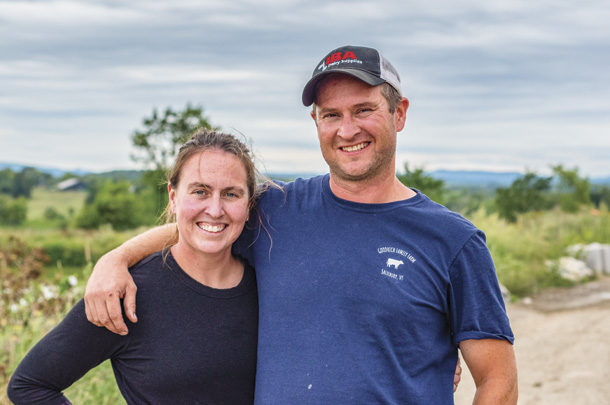Manure is a fact of life on the dairy farm. Sooner or later, every dairy is confronted with added costs associated with managing and disposing of manure.
And, even though manure is universally accepted as an indispensable source of plant nutrients and soil amendments, it’s generally regarded as a nuisance that most dairy farmers would gladly avoid if it were possible.
Ironically, though, for all the challenges associated with manure, there’s a positive side to this organic substance, as a source of renewable energy that goes well beyond its traditional use as a fertilizer. Slow to emerge, there is a growing industry focused on collecting and marketing the biomethane produced by the anaerobic fermentation of manure.
Capturing methane on dairies is certainly not a new concept. Industries have recognized the marketable value of this renewable energy source for decades. However, building facilities and processing biogas is a complex and expensive undertaking – something most dairy farms do not have the funds, time or expertise to do. Dairy farms find themselves between a rock and a hard place as they continue to struggle financially in an industry with chronically low milk prices and the trend to grow herd sizes to attain greater efficiencies and economies of scale. More cows means more poop that must to be stored, managed, processed and disposed of in a more stringent regulatory environment.
Companies specializing in mitigating challenges posed by agricultural waste are now partnering with dairy farms. Vanguard Renewables located in Wellesley, Massachusetts, is one such company that is working with dairy farms across the nation in developing systems to solve organic waste disposal challenges, while at the same time producing renewable natural gas that will generate an income stream. This is a win-win for the dairy industry, as it dramatically reduces methane being released into the atmosphere.
Because of the nearly uncontained and unstoppable production of methane escaping from the majority of dairy manure storage tanks and lagoons, animal agriculture in general, and the dairy industry in particular, has been singled out as a major contributor to global warming, due to methane’s ability to absorb the sun’s heat. Dairy farmers have learned – some the hard way – they must conform to a changing set of standards, which now includes the environmentally responsible handling of their waste products. Dairy farmers, today, must shift their thinking so as to stay one step ahead of critics of animal agriculture and be proactive in how they present their industry to capricious consumers and environmentalists bent on shutting down animal agriculture.
In Salisbury, Vermont, three generations of the Goodrich family have been dairy farming since 1956. Beginning with just a handful of cows, the dairy has increased in size in steps over the years and currently milks 900 cows. Brother and sister team Chase and Danielle Goodrich, having both graduated from college in 2009 and both wanting to stay working on the dairy, now assume the dairy’s day-to-day management responsibilities, with Chase focusing on the crops and farming and Danielle managing the dairy herd.
Danielle states her interest in capturing methane goes back more than a decade – long before the herd size made it to 900 cows – when one of her college professors suggested the idea. The family thought the idea had merit and eventually contracted with Vanguard Renewables to design, build and manage an anaerobic manure-digestion system that would enable the dairy to capture, purify and market biomethane, as well as provide a digestate/fertilizer that’s much more environmentally friendly and easier to apply.
“Knowing that milk prices will always be volatile and cyclical, we see this as a way to diversify our income source,” Danielle says. “And, knowing that, at the same time, we’re doing a favorable thing for the environment; [this project] is a no-brainer.”
The added income stream for the Goodrich Dairy comes in the form of a lease payment from Vanguard Renewables for use of the property. Goodrich Dairy receives no income from sale of the methane produced at the farm. Vanguard essentially rents property on the farm to conduct its methane production operations.
John Hanselman, CEO of Vanguard Renewables, explains that a decade ago, the prevailing thinking was methane produced on a farm would be used to power a generator to produce electricity, to then be fed into a local power grid. That’s all changed, Hanselman says. Another renewable energy source, solar power from photovoltaics, has become so inexpensive in recent years, that producing renewable energy and converting it to electricity at the farm in a large generator is no longer a viable option. Instead, Vanguard focuses solely on producing methane at the dairy farm and selling it directly to end users or a gas utility.
One caveat in the production of methane from straight cow manure is that the anaerobic digestion of manure is not very efficient. Hanselman and his team of engineers and chemists learned many years ago that the introduction of food waste coming from grocery stores, restaurants, beverage manufacturers and the like, when combined with manure, greatly increases the efficiency of anaerobic digestion and ultimately produces more methane from a given amount of organic matter.
With the addition of food waste to the digestion process, Vanguard Renewables helps solve a second nagging environmental challenge – tons of food waste being sent to landfills. Now, food waste can also be tapped for its renewable energy value, all while reducing the strain on solid waste landfills.
Projects of this magnitude are no small undertaking. Mature Holstein cows produce over 100 pounds of manure and urine per day. That’s 90,000 pounds of raw manure just from the milk cows. For a herd this size, Vanguard is building both underground and aboveground holding tanks with multi-million gallon capacities for both manure from the dairy herd and incoming food waste trucked in from multiple sources in the region. The manure and food waste are then blended together in another massive tank, where the anaerobic digestion and biogas production occurs under carefully monitored conditions.
According to Hanselman, even though the COVID-19 pandemic has unfortunately slowed the project down, about 65% of the gas produced at the Goodrich dairy is slated to be piped directly up the road to a local school where it will provide 100% of the school’s thermal needs – both heating and cooling. The other 35% is being sold to Vermont Gas Systems Inc.
After the methane has been extracted, the remaining digestate is stored and eventually spread on the Goodrich farmland – about 1,400 acres – in a much drier and easier-to-handle form that’s less odoriferous. Additionally, new technology will also be removing much of the phosphorus from the digestate, enabling Chase to dramatically reduce excessive levels of phosphorus going onto the land – a common challenge and limiting factor of spreading dairy manure straight from the holding pond.
The Goodrich family is essentially in the same boat as most other dairy farms in the U.S. – constantly looking for ways to reduce expenses as costs of production continue to escalate, while milk prices continue their cycles of volatility, and the milk price in real dollars continues to decline.
Chase states the farm has reached a herd size they would like to sustain. The land base around the dairy is limiting any future growth, and they really don’t want to produce more milk. They need to find ways to produce milk for less cost.
“Danielle and I would like to make our livings here for [many years], but we had to look for ways to avoid making more milk,” Chase says.
Partnering with management companies like Vanguard Renewables and producing renewable energy may not be in the cards for every dairy farm. But, for the Goodrich Dairy, it’s a good fit that will offset production costs and have a positive impact on their bottom line, as well as reducing environmental impact and lowering the carbon footprint of the dairy farm.









